L17-名称的限定词 初中英语词性句法新讲课件(共18张PPT)
文档属性
| 名称 | L17-名称的限定词 初中英语词性句法新讲课件(共18张PPT) | 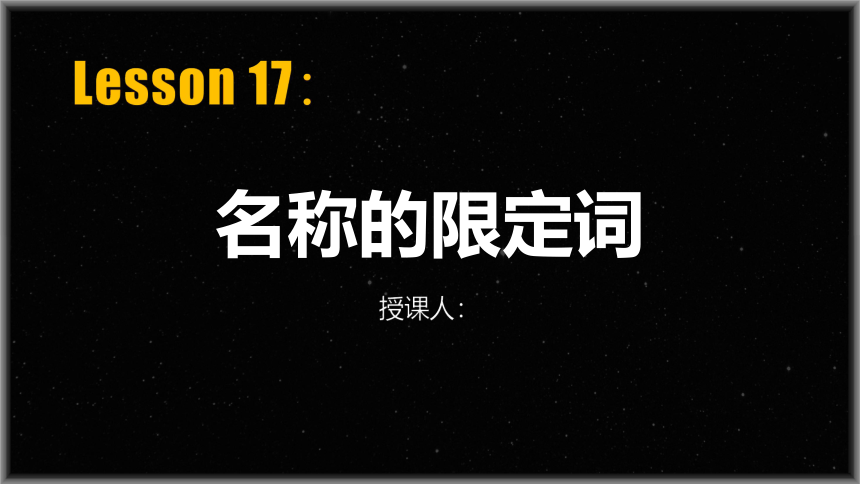 | |
| 格式 | ppt | ||
| 文件大小 | 1.2MB | ||
| 资源类型 | 试卷 | ||
| 版本资源 | 通用版 | ||
| 科目 | 英语 | ||
| 更新时间 | 2022-04-10 22:23:43 | ||
图片预览


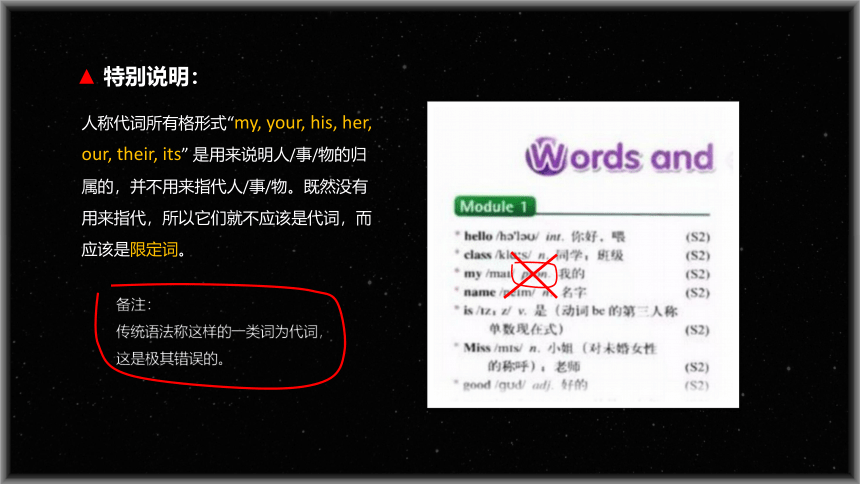

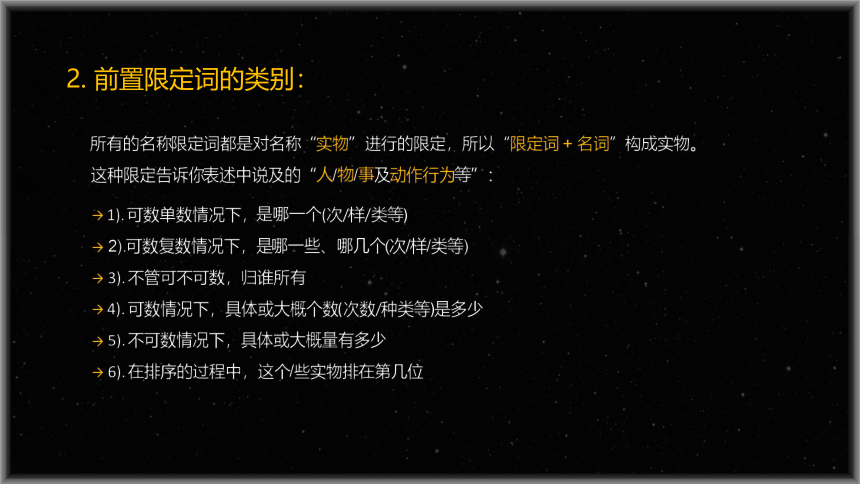
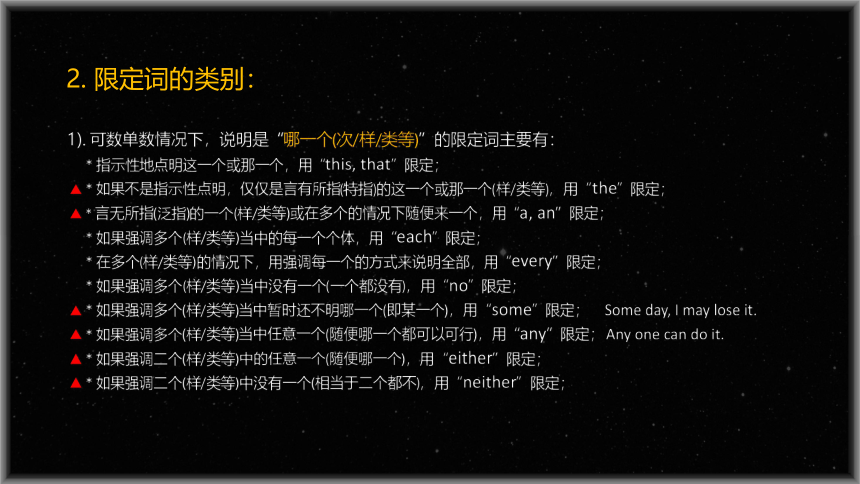
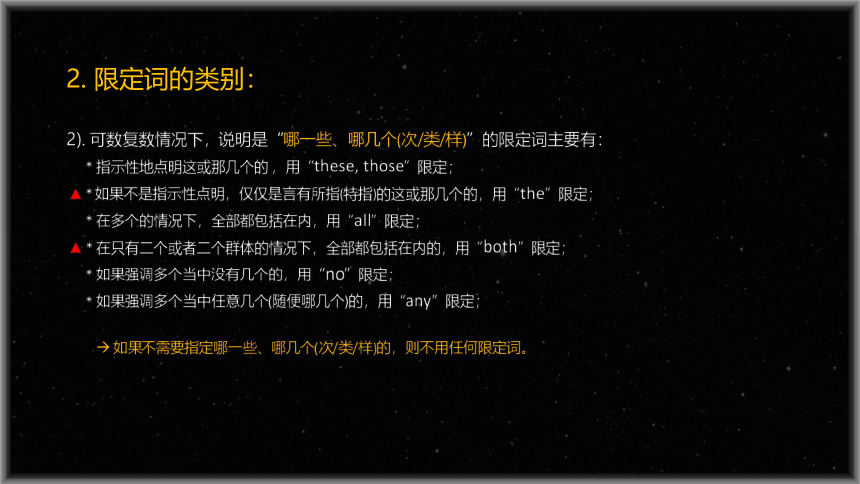
文档简介
(共18张PPT)
名称的限定词
Lesson 17:
授课人:
1. 限定词的概念:
放在名词前面,让一个名称概念
词变成实物,同时又对这个名称
物进行了相关的限定。这样的一
类词,叫限定词。英文叫“determiner”。
限定词是个特殊的概念,它没有
出现在词类中。但是在现代词典
中却有明确标示。
▲ 特别说明:
备注:
传统语法称这样的一类词为代词,
这是极其错误的。
人称代词所有格形式“my, your, his, her, our, their, its” 是用来说明人/事/物的归
属的,并不用来指代人/事/物。既然没有
用来指代,所以它们就不应该是代词,而
应该是限定词。
泛指特指限定:
a, an, the
2. 前置限定词的类别:
职位礼称限定:
Mr., Mrs., Ms., Prof., Dr., …
明确指示限定:
this, that, these, those
归属标签限定:
my/your …, Tom’s …, the dog’s …, women’s …, my parents’..., someone else’s, …
疑问归属限定:
whose car, what colour, which class
明确个数限定:
no man, one, two, three, … (全部数词), all, each, both, either, neither, …
不明个数限定:
many, some, any, few, a few, all, not all, half, …
不明确量限定:
much, some, any, little, a little, all, not all, half, …
序数排位限定:
the first, the second, the third, the fourth, the fifth, …
(不带the的时候,则归入到形容词限定词)
2. 前置限定词的类别:
所有的名称限定词都是对名称“实物”进行的限定,所以“限定词 + 名词”构成实物。
这种限定告诉你表述中说及的“人/物/事及动作行为等”:
1). 可数单数情况下,是哪一个(次/样/类等)
2).可数复数情况下,是哪一些、哪几个(次/样/类等)
3). 不管可不可数,归谁所有
4). 可数情况下,具体或大概个数(次数/种类等)是多少
5). 不可数情况下,具体或大概量有多少
6). 在排序的过程中,这个/些实物排在第几位
2. 限定词的类别:
1). 可数单数情况下,说明是“哪一个(次/样/类等)”的限定词主要有:
* 指示性地点明这一个或那一个,用“this, that”限定;
▲ * 如果不是指示性点明,仅仅是言有所指(特指)的这一个或那一个(样/类等),用“the”限定;
▲ * 言无所指(泛指)的一个(样/类等)或在多个的情况下随便来一个,用“a, an”限定;
* 如果强调多个(样/类等)当中的每一个个体,用“each”限定;
* 在多个(样/类等)的情况下,用强调每一个的方式来说明全部,用“every”限定;
* 如果强调多个(样/类等)当中没有一个(一个都没有),用“no”限定;
▲ * 如果强调多个(样/类等)当中暂时还不明哪一个(即某一个),用“some”限定; Some day, I may lose it.
▲ * 如果强调多个(样/类等)当中任意一个(随便哪一个都可以可行),用“any”限定; Any one can do it.
▲ * 如果强调二个(样/类等)中的任意一个(随便哪一个),用“either”限定;
▲ * 如果强调二个(样/类等)中没有一个(相当于二个都不),用“neither”限定;
2. 限定词的类别:
2). 可数复数情况下,说明是“哪一些、哪几个(次/类/样)”的限定词主要有:
* 指示性地点明这或那几个的 ,用“these, those”限定;
▲ * 如果不是指示性点明,仅仅是言有所指(特指)的这或那几个的,用“the”限定;
* 在多个的情况下,全部都包括在内,用“all”限定;
▲ * 在只有二个或者二个群体的情况下,全部都包括在内的,用“both”限定;
* 如果强调多个当中没有几个的,用“no”限定;
* 如果强调多个当中任意几个(随便哪几个)的,用“any”限定;
如果不需要指定哪一些、哪几个(次/类/样)的,则不用任何限定词。
2. 限定词的类别:
3). 不管可不可数,说明“归谁所有”的限定词主要有:
名词所有格:
* 名词单数对应的限定词:Tom’s (brother), the dog’s (tail), ...
someone else’s (idea), each other’s (plan), the tailor’s (shop), …
* 名词复数对应的限定词:the Children’s (Day), women’s (rights), …
▲my parents’ (photo), the students’ (room), ...
* 疑问情况下的限定词: whose (car), what (colour), which (class)
代词所有格:
人称/物称代词对应的限定词:my ..., your ..., his..., her ..., our ..., their ..., its ...
2. 限定词的类别:
4). 可数情况下,说明“具体或大概个数(次数/种类等)”的限定词主要有:
* 如果是零个(即一个都没有),用“no”来限定;
* 如果只有一个,用“one”来限定,个体物名词用单数形式;
* 其它具体多少个,用“two, three, four, ...”等具体的数字词来限定,个体物名词用复数形式;
* 其它只说大概数的,用“few, a few, several, some, half, many, most, ...”等不定限定词来限定;
* 说明一定数量的,用“a number of ...”等限定短语来限定;
* 强调单只(单个/单身),用“single”来限定;
* 强调同一事/物成双出现,用“double”来限定;
......
2. 限定词的类别:
5). 不可数情况下,说明“具体或大概量”的限定词主要有:
* 完全没有,用“no”来限定;
* 几乎没有,用“little”来限定;
* 很少,只有一点点量,用“a little”来限定;
* 肯定语气下的一定量,用“some”来限定;疑问语气或否定语气下的一定量,用“any”来限定;
* 大量的,用“much”来限定;
* 全部的,用“all”来限定;并非全部的,用“not all”来限定;
* 一半的,用“half”来修饰限定;
......
▲另外,对不可数名称物的特指,用“the”来进行限定。注意不能用“this/that, these/those”。
2. 限定词的类别:
6). 特指情况下,表顺序的限定:
the first, the second, the third, the fourth, the fifth, …
不是特指情况下,表顺序的修饰:
I get a second apple from him.
He got a third call from his father.
3. 限定词+形容词构成名称:
限定词后面也可接形容词,“限定词 + 形容词”指具备符合这种描述的一类人/事/物。比如:
the rich, the young, the poor, the honest, …
▲ 在不特指的情况下,其它限定词也可以,比如:some olds, Eight Strongs, those blacks, …
They look quite different from the youngs. all the livings, …
有用复数形式表示的:
those wounded, …
特指一类具备这种描述属性的人
I don’t want the black pen, I want the blue (one).
He won the first, and I got the second. You are the last.
the taller of the two, the youngest of the class, …
特指一个
也有不用复数形式的:
4. 限定词使用注意事项:
▲ 特别注意:
注意不可数名称物没有任意一个的泛指限定,所以不可数情况下的名称词,不能用“a/an”来进行
限定。比如不可以说:
a(n) bread (rain, meat, gold….)
▲ 同样,用来表“数”的限定词不能限定不可数的名称词。比如不可以说:
this(these) water, that(those) milk, ...
two milks (ices, hairs) , …
many water, few rain, a few snow, ...
a number of liquid, the number of liquid, ...
4. 限定词使用注意事项:
▲ 既可以用来表“数”,又可以用来表“量”的限定词:
no, some, any, half, most, all, ...
a large quantity of ...
5. 限定词与指代词同形:
1). 绝大多数限定词可以兼做代称词,所以可以同时用来指代所修饰的那个词。比如可以说:
many students = many of the students
each boy = each of the boys
all the windows = all of the windows
three lakes = three of the lakes
much work = much of the work
......
2). 但下列这些“表数或表量的单位”的词则只能用来对它们进行指代:
a lot of trees, lots of seeds,
a great deal of ..., a large amount of ..., ...
hundreds of rice, …
6. 前置限定词的排序:
注意1:一类限定词一般无法并列同时使用。比如:
这一本有趣的书:
汤姆的这些笔:
不能表述为:this an interesting book
不能表述为:Tom’s these pens
要表述为:this interesting book 或:the interesting book
要表述为:Tom’s pens 或:these (the) pens of Tom’s
*归属指代不强时也可以并用,但指代要放第一位。比如:
加利福尼亚的那些农场:
要表述为:those California’s farms
6. 前置限定词的排序:
注意2:有些时候,二类限定词也无法跟一类限定词并列同时使用。比如:
我的许多朋友:
汤姆的一个朋友:
很容易表述为 :Tom’s one friend
很容易表述为:my many friends
要表述为:Tom’s friend, 或:one of Tom’s friends 或:one friend of Tom’s
要表述为:many of my friends 或:many friends of mine
你的一些英语书:
不能表述为:your some English books
要表述为:some of your English books 或:some English books of yours
* 如果可以并用,二类限定词一般排在一类限定词后面。比如:the two students ...
6. 前置限定词的排序:
并不是这里的所有的人:要表述为:not all the people here
所有的外国学生:
不能表述为:the all foreign students
更多实例:
both the kids, many a student, such a wonderful film(so wonderful a film), how nice a lady, …
要表述为:all the foreign students
* 但也有例外,在强调的情况下,部分二类限定词要提前,遵循关键词优先原则。比如:
名称的限定词
Lesson 17:
授课人:
1. 限定词的概念:
放在名词前面,让一个名称概念
词变成实物,同时又对这个名称
物进行了相关的限定。这样的一
类词,叫限定词。英文叫“determiner”。
限定词是个特殊的概念,它没有
出现在词类中。但是在现代词典
中却有明确标示。
▲ 特别说明:
备注:
传统语法称这样的一类词为代词,
这是极其错误的。
人称代词所有格形式“my, your, his, her, our, their, its” 是用来说明人/事/物的归
属的,并不用来指代人/事/物。既然没有
用来指代,所以它们就不应该是代词,而
应该是限定词。
泛指特指限定:
a, an, the
2. 前置限定词的类别:
职位礼称限定:
Mr., Mrs., Ms., Prof., Dr., …
明确指示限定:
this, that, these, those
归属标签限定:
my/your …, Tom’s …, the dog’s …, women’s …, my parents’..., someone else’s, …
疑问归属限定:
whose car, what colour, which class
明确个数限定:
no man, one, two, three, … (全部数词), all, each, both, either, neither, …
不明个数限定:
many, some, any, few, a few, all, not all, half, …
不明确量限定:
much, some, any, little, a little, all, not all, half, …
序数排位限定:
the first, the second, the third, the fourth, the fifth, …
(不带the的时候,则归入到形容词限定词)
2. 前置限定词的类别:
所有的名称限定词都是对名称“实物”进行的限定,所以“限定词 + 名词”构成实物。
这种限定告诉你表述中说及的“人/物/事及动作行为等”:
1). 可数单数情况下,是哪一个(次/样/类等)
2).可数复数情况下,是哪一些、哪几个(次/样/类等)
3). 不管可不可数,归谁所有
4). 可数情况下,具体或大概个数(次数/种类等)是多少
5). 不可数情况下,具体或大概量有多少
6). 在排序的过程中,这个/些实物排在第几位
2. 限定词的类别:
1). 可数单数情况下,说明是“哪一个(次/样/类等)”的限定词主要有:
* 指示性地点明这一个或那一个,用“this, that”限定;
▲ * 如果不是指示性点明,仅仅是言有所指(特指)的这一个或那一个(样/类等),用“the”限定;
▲ * 言无所指(泛指)的一个(样/类等)或在多个的情况下随便来一个,用“a, an”限定;
* 如果强调多个(样/类等)当中的每一个个体,用“each”限定;
* 在多个(样/类等)的情况下,用强调每一个的方式来说明全部,用“every”限定;
* 如果强调多个(样/类等)当中没有一个(一个都没有),用“no”限定;
▲ * 如果强调多个(样/类等)当中暂时还不明哪一个(即某一个),用“some”限定; Some day, I may lose it.
▲ * 如果强调多个(样/类等)当中任意一个(随便哪一个都可以可行),用“any”限定; Any one can do it.
▲ * 如果强调二个(样/类等)中的任意一个(随便哪一个),用“either”限定;
▲ * 如果强调二个(样/类等)中没有一个(相当于二个都不),用“neither”限定;
2. 限定词的类别:
2). 可数复数情况下,说明是“哪一些、哪几个(次/类/样)”的限定词主要有:
* 指示性地点明这或那几个的 ,用“these, those”限定;
▲ * 如果不是指示性点明,仅仅是言有所指(特指)的这或那几个的,用“the”限定;
* 在多个的情况下,全部都包括在内,用“all”限定;
▲ * 在只有二个或者二个群体的情况下,全部都包括在内的,用“both”限定;
* 如果强调多个当中没有几个的,用“no”限定;
* 如果强调多个当中任意几个(随便哪几个)的,用“any”限定;
如果不需要指定哪一些、哪几个(次/类/样)的,则不用任何限定词。
2. 限定词的类别:
3). 不管可不可数,说明“归谁所有”的限定词主要有:
名词所有格:
* 名词单数对应的限定词:Tom’s (brother), the dog’s (tail), ...
someone else’s (idea), each other’s (plan), the tailor’s (shop), …
* 名词复数对应的限定词:the Children’s (Day), women’s (rights), …
▲my parents’ (photo), the students’ (room), ...
* 疑问情况下的限定词: whose (car), what (colour), which (class)
代词所有格:
人称/物称代词对应的限定词:my ..., your ..., his..., her ..., our ..., their ..., its ...
2. 限定词的类别:
4). 可数情况下,说明“具体或大概个数(次数/种类等)”的限定词主要有:
* 如果是零个(即一个都没有),用“no”来限定;
* 如果只有一个,用“one”来限定,个体物名词用单数形式;
* 其它具体多少个,用“two, three, four, ...”等具体的数字词来限定,个体物名词用复数形式;
* 其它只说大概数的,用“few, a few, several, some, half, many, most, ...”等不定限定词来限定;
* 说明一定数量的,用“a number of ...”等限定短语来限定;
* 强调单只(单个/单身),用“single”来限定;
* 强调同一事/物成双出现,用“double”来限定;
......
2. 限定词的类别:
5). 不可数情况下,说明“具体或大概量”的限定词主要有:
* 完全没有,用“no”来限定;
* 几乎没有,用“little”来限定;
* 很少,只有一点点量,用“a little”来限定;
* 肯定语气下的一定量,用“some”来限定;疑问语气或否定语气下的一定量,用“any”来限定;
* 大量的,用“much”来限定;
* 全部的,用“all”来限定;并非全部的,用“not all”来限定;
* 一半的,用“half”来修饰限定;
......
▲另外,对不可数名称物的特指,用“the”来进行限定。注意不能用“this/that, these/those”。
2. 限定词的类别:
6). 特指情况下,表顺序的限定:
the first, the second, the third, the fourth, the fifth, …
不是特指情况下,表顺序的修饰:
I get a second apple from him.
He got a third call from his father.
3. 限定词+形容词构成名称:
限定词后面也可接形容词,“限定词 + 形容词”指具备符合这种描述的一类人/事/物。比如:
the rich, the young, the poor, the honest, …
▲ 在不特指的情况下,其它限定词也可以,比如:some olds, Eight Strongs, those blacks, …
They look quite different from the youngs. all the livings, …
有用复数形式表示的:
those wounded, …
特指一类具备这种描述属性的人
I don’t want the black pen, I want the blue (one).
He won the first, and I got the second. You are the last.
the taller of the two, the youngest of the class, …
特指一个
也有不用复数形式的:
4. 限定词使用注意事项:
▲ 特别注意:
注意不可数名称物没有任意一个的泛指限定,所以不可数情况下的名称词,不能用“a/an”来进行
限定。比如不可以说:
a(n) bread (rain, meat, gold….)
▲ 同样,用来表“数”的限定词不能限定不可数的名称词。比如不可以说:
this(these) water, that(those) milk, ...
two milks (ices, hairs) , …
many water, few rain, a few snow, ...
a number of liquid, the number of liquid, ...
4. 限定词使用注意事项:
▲ 既可以用来表“数”,又可以用来表“量”的限定词:
no, some, any, half, most, all, ...
a large quantity of ...
5. 限定词与指代词同形:
1). 绝大多数限定词可以兼做代称词,所以可以同时用来指代所修饰的那个词。比如可以说:
many students = many of the students
each boy = each of the boys
all the windows = all of the windows
three lakes = three of the lakes
much work = much of the work
......
2). 但下列这些“表数或表量的单位”的词则只能用来对它们进行指代:
a lot of trees, lots of seeds,
a great deal of ..., a large amount of ..., ...
hundreds of rice, …
6. 前置限定词的排序:
注意1:一类限定词一般无法并列同时使用。比如:
这一本有趣的书:
汤姆的这些笔:
不能表述为:this an interesting book
不能表述为:Tom’s these pens
要表述为:this interesting book 或:the interesting book
要表述为:Tom’s pens 或:these (the) pens of Tom’s
*归属指代不强时也可以并用,但指代要放第一位。比如:
加利福尼亚的那些农场:
要表述为:those California’s farms
6. 前置限定词的排序:
注意2:有些时候,二类限定词也无法跟一类限定词并列同时使用。比如:
我的许多朋友:
汤姆的一个朋友:
很容易表述为 :Tom’s one friend
很容易表述为:my many friends
要表述为:Tom’s friend, 或:one of Tom’s friends 或:one friend of Tom’s
要表述为:many of my friends 或:many friends of mine
你的一些英语书:
不能表述为:your some English books
要表述为:some of your English books 或:some English books of yours
* 如果可以并用,二类限定词一般排在一类限定词后面。比如:the two students ...
6. 前置限定词的排序:
并不是这里的所有的人:要表述为:not all the people here
所有的外国学生:
不能表述为:the all foreign students
更多实例:
both the kids, many a student, such a wonderful film(so wonderful a film), how nice a lady, …
要表述为:all the foreign students
* 但也有例外,在强调的情况下,部分二类限定词要提前,遵循关键词优先原则。比如:
同课章节目录
- 词法
- 名词
- 动词和动词短语
- 动词语态
- 动词时态
- 助动词和情态动词
- 非谓语动词
- 冠词
- 代词
- 数词和量词
- 形容词副词及其比较等级
- 介词和介词短语
- 连词和感叹词
- 构词法
- 相似、相近词比较
- 句法
- 陈述句
- 一般疑问句和否定疑问句
- 特殊疑问句及选择疑问句
- 反意疑问句
- 存在句(There be句型)
- 宾语从句
- 定语从句
- 状语从句
- 主谓一致问题
- 简单句
- 并列句
- 复合句
- 主谓一致
- 主、表语从句
- 名词性从句
- 直接引语和间接引语
- 虚拟语气
- 感叹句
- 强调句
- 倒装句
- 祈使句
- 句子的成分
- 句子的分类
- 题型专区
- 单项选择部分
- 易错题
- 完形填空
- 阅读理解
- 词汇练习
- 听说训练
- 句型转换
- 补全对话
- 短文改错
- 翻译
- 书面表达
- 任务型阅读
- 语法填空
- 其他资料
